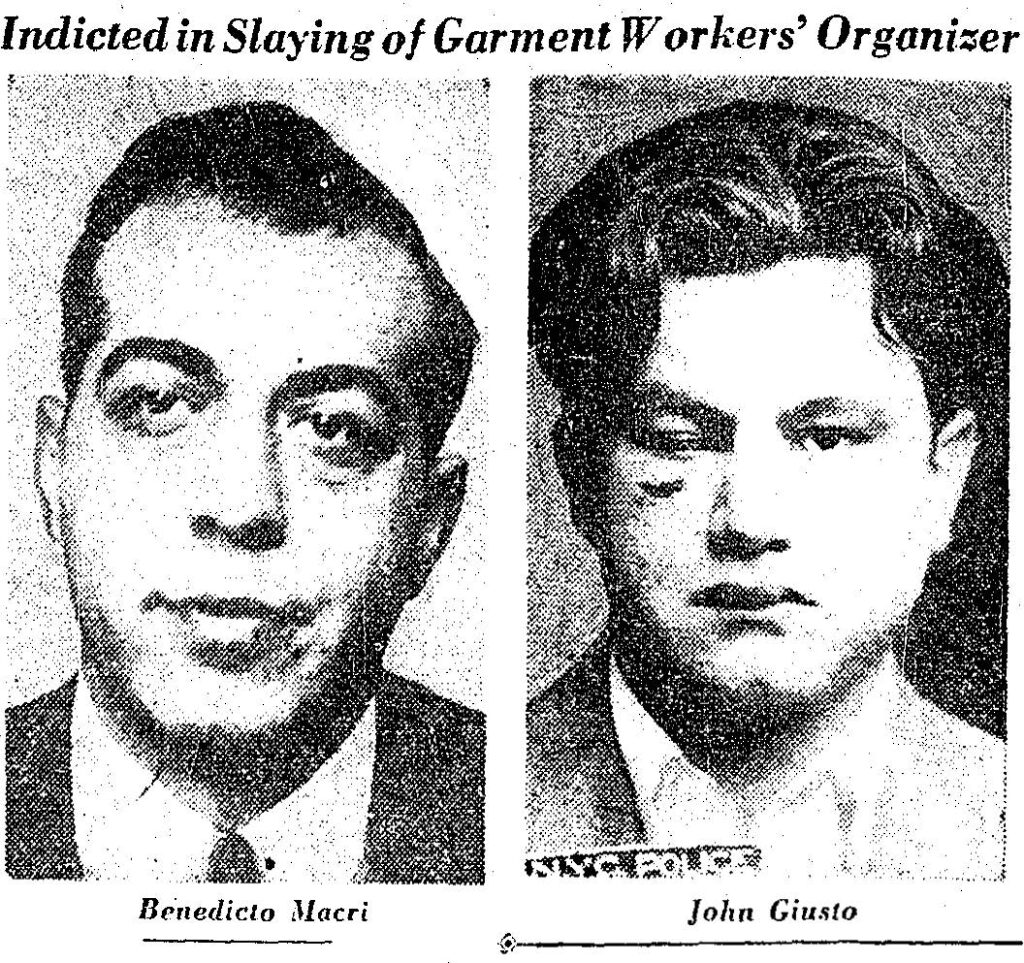This Day in Labor History: May 9, 1949

On May 9, 1949, mob thugs assassinated International Ladies Garment Workers Union organizer William Lurye in a blatant to keep New York garment trade shops union-free. They got away with it. This kind of violence used against union organizers was all too common in mid-twentieth century New York City and law enforcement and politicians didn’t care enough to do anything about it.
Lurye was an organizer for a democratic union. He was 37 years old and the father of four. He had spent years as a dress presser, ironing garments before they went to the stores. It wasn’t a great job, but it paid pretty well thanks to the union contracts the ILGWU had won. Earlier in 1949, he took a big pay cut to work directly for the ILG as an organizer. The goal here was to press the non-union operators to stop their anti-union activities and accept the ILG as the bargaining agent of the workers. The union didn’t have much money to pay organizers, so it relied on those truly committed to unionism to take some time and sacrifice for the union. Lurye would pay the ultimate sacrifice for the cause.
The mafia had established themselves in unions thanks to the cops really not caring. Given the overall anti-union attitude of everyone in the American power structure, no one was going to do much if organized crime began shoving their way into the labor movement. So for a lot of unions, it simply ended up making sense to cut a deal with the mob rather than getting cut yourself. The ILG was generally not one of these unions though. Having cut its teeth in the intense garment strikes of the 1900s and 1910s that included the conditions around the Triangle Fire, this was a union that was willing to fight, even if did not have the radical socialist politics of its old days. Meanwhile, non-union producers saw the mafia as an outright ally. In such a cutthroat industry, with such low capital investment to get started that overcompetition was always a problem, some of these operators would do anything to gain an advantage. Avoiding the union was definitely an advantage. Paying the mob to off ILG organizers was a more extreme act, but one that at least some operators were happy to do.
On May 9, mob thugs grabbed him while he walked the streets, shoved him into a phone booth, and then proceeded to stab him in the next with an ice pick, killing him. There was a sad irony to this. Lurye’s father Max had been a cigarmaker in Chicago blacklisted for organizing. When he started in the junk industry in order to support himself, Al Capone tried to force him out. Max Lurye had attacked Capone publicly, throwing his thugs off the stage at the Junkmen’s Union meeting who demanded protection. For this, Capone attempted to kill Max. He was wounded and survived having only lost a leg to amputation, though his friend was not so lucky. So Lurye grew up in a tradition of hating both bad unionism and the mafia. Both would pay for fighting these thugs.
A week after William’s death, Max died of a broken heart.
ILGWU head David Dubinsky was furious and outraged. He stated Lurye was “struck down in cold blood by murderers in the hire of anti-union sweatshoppers who would rather spill blood than carry on production in the sane and civilized manner to which the majority of garment employers are committed.” A few days later, 65,000 garment workers walked off the job in an action to honor Lurye and express their disgust at the mafia.
It took over a year to find the killers. No one wanted to talk. The whole point of the action was that the mob could murder whoever they wanted in broad daylight in the middle of New York City and get away with it and this is what would happen if the ILG continued to organize. The union posted a $25,000 reward. Didn’t matter. Finally, Benedetto Macri and John Giusto were indicted. Walter Winchell convinced Macri to surrender and he then donated the reward to the Damon Runyon Cancer Fund. Macri worked for a guy named Albert Anastasia, who was a gangster who also ran a non-union shop. But even then, the jury acquitted Macri for a lack of evidence. A bookmaker named Sam Blumenthal originally testified that he saw Macri kill Lurye. He then changed his mind on the stand and denied it all. Sure, he was then charged with perjury. Better than the death he realized he was about to face if he went through on his testimony.
This was the height of the American labor movement. The ILG was a powerful and respectable union. It didn’t matter. The forces of order in this nation were never going to go to the mat for the unions. Macri and Giusto simply followed orders. The guys who ordered the hit? The politicians and cops paid off by the guys who ordered the hit? They weren’t touching any of this. This is how unions had to acquiesce in some industries to the mob–the other choice was death. In the case of the ILG, they never did acquiesce, but the industry simply left New York and the union declined to a shell of its past by the 1970s.
I borrowed from David Witwer and Catherine Rios’ Murder in the Garment District: The Grip of Organized Crime and the Decline of Labor in the United States to write this post. This is a fantastic book and I strongly recommend it to you all.
This is the 519th post in this series. Previous posts in this series are archived here.


